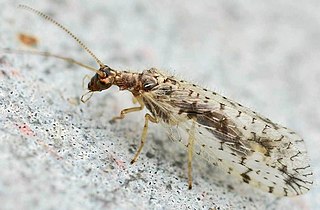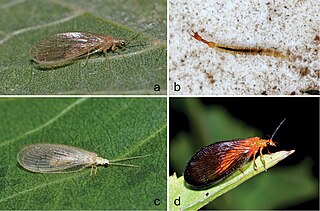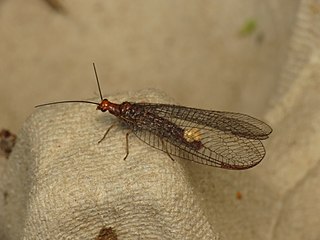
The insect order Neuroptera, or net-winged insects, includes the lacewings, mantidflies, antlions, and their relatives. The order consists of some 6,000 species. Neuroptera can be grouped together with the Megaloptera and Raphidioptera in the unranked taxon Neuropterida including: alderflies, fishflies, dobsonflies, and snakeflies.

Green lacewings are insects in the large family Chrysopidae of the order Neuroptera. There are about 85 genera and 1,300–2,000 species in this widespread group. Members of the genera Chrysopa and Chrysoperla are very common in North America and Europe; they are very similar and many of their species have been moved from one genus to the other time and again, and in the nonscientific literature assignment to Chrysopa and Chrysoperla can rarely be relied upon. Since they are the most familiar neuropterans to many people, they are often simply called "lacewings". Since most of the diversity of Neuroptera are properly referred to as some sort of "lacewing", common lacewings is preferable.

Mantispidae, known commonly as mantidflies, mantispids, mantid lacewings, mantisflies or mantis-flies, is a family of small to moderate-sized insects in the order Neuroptera. There are many genera with around 400 species worldwide, especially in the tropics and subtropics. Only 5 species of Mantispa occur in Europe. As their names suggest, members of the group possess raptorial forelimbs similar to those of praying mantis, a case of convergent evolution.

Osmylidae are a small family of winged insects of the net-winged insect order Neuroptera. The osmylids, also called stream lacewings or giant lacewings, are found all over the world. A common species through most of Europe is Osmylus fulvicephalus, they are the only family known within the suborder Osmyliformia.

Hemerobiidae is a family of Neuropteran insects commonly known as brown lacewings, comprising about 500 species in 28 genera. Most are yellow to dark brown, but some species are green. They are small; most have forewings 4–10 mm long. These insects differ from the somewhat similar Chrysopidae not only by the usual coloring but also by the wing venation: hemerobiids differ from chrysopids in having numerous long veins and forked costal cross veins. Some genera are widespread, but most are restricted to a single biogeographical realm. Some species have reduced wings to the degree that they are flightless. Imagines (adults) of subfamily Drepanepteryginae mimic dead leaves. Hemerobiid larvae are usually less hairy than chrysopid larvae.

The Nevrorthidae, often incorrectly spelled "Neurorthidae", are a small family of winged insects of the order Neuroptera. Extant species may be described as living fossils. There are 19 extant species in four genera, with a geographically disjunct distribution, Nevrorthus, comprising 5 species with scattered distributions around the Mediterranean, Austroneurorthus with two species known from southeastern Australia, Nipponeurorthus comprising 11 species known from China and Japan, and Sinoneurorthus known from a single species described from Yunnan Province, China. They were at one time placed in the Osmyloidea, with the Osmylidae and the spongillaflies (Sisyridae) as their closest relatives, but nowadays they are considered to be the most ancient lineage of living lacewings. Sometimes they are placed in a suborder Nevrorthiformia, but the quite basal position of the family is probably better expressed by placing them directly in the Neuroptera, without assigning the subordinal rank.

Chrysoperla is a genus of common green lacewings in the neuropteran family Chrysopidae. Therein they belong to the Chrysopini, the largest tribe of subfamily Chrysopinae.

Chrysopinae is a subfamily of green lacewings in the insect family Chrysopidae in the order Neuroptera. They are the nominate taxon and largest member of the green lacewing family (Chrysopidae), containing about 60 genera.

Semachrysa jade is a species of green lacewing from the Malaysian states of Perak, Selangor and Sabah. So far, very few specimens have been found, all female. They exhibit extensive black markings on the basal portion of both wings, which differentiates them from the 14 other species in the genus Semachrysa.

Sympherobius is a genus of brown lacewings in the family Hemerobiidae. There are at least 50 described species in Sympherobius.

Chrysopini is a tribe of green lacewings in the family Chrysopidae. There are about 17 genera and at least 300 described species in Chrysopini.

Abachrysa is a genus of green lacewings in the family Chrysopidae. There is one described species in Abachrysa, Abachrysa eureka.

Nothochrysa is a genus of green lacewings in the family Chrysopidae. There are about 10 described species in Nothochrysa.

Dendroleon is a genus of antlions in the family Myrmeleontidae. There are more than 20 described species in Dendroleon.

Leucochrysa is a genus of green lacewings in the family Chrysopidae. There are more than 180 described species in Leucochrysa.

Psectra is a genus of brown lacewings in the family Hemerobiidae. There are more than 20 described species in Psectra.

Nusalala is a genus of brown lacewings. The scientific name was published in 1913 by Longinos Navás. They belong to the subfamily Microminae, as well as the genera Micromus and Megalomina.
Some species of this genus, such as Nusalala brachyptera, are "brachypter" meaning short wings, and have lost the ability to fly; they can only jump. This phenomenon has evolved in a number of genera in the family Hemerobiidae

Pseudomallada is a genus of green lacewings in the family Chrysopidae. There are more than 160 described species in Pseudomallada.
Yumachrysa is a genus of green lacewings in the family Chrysopidae. There are at least four described species in Yumachrysa.

Mallada basalis is a species of green lacewing in the family Chrysopidae, first described by Francis Walker in 1853. No subspecies are listed in the Catalog of Life. The species was detected on mainland New Zealand in the 2010s.



















